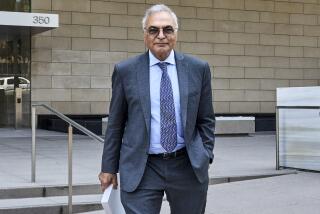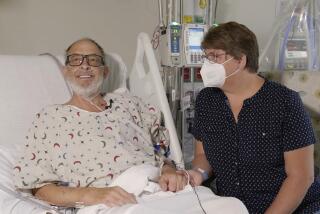Artificial Pancreas Aids Diabetic Man : Medicine: Doctor says membrane that secretes insulin has proved a success and implants a second. It is hoped it will completely free the patient from injections.
An artificial pancreas implanted in a Lake Isabella diabetic six months ago to test its safety--the first and apparently only such implant ever done in the United States--has proved so effective that surgeons Monday made a second implant in an effort to completely free the patient from insulin shots.
The new implant, performed like the first at St. Vincent Medical Center, consists of insulin-secreting islet cells encapsulated in a porous membrane that protects them from attack by the immune system.
The patient, Steven Craig, 38, has been diabetic for more than 30 years and unable to work for the past seven because of complications from the disease. After the first transplant, Craig’s insulin requirement was reduced 90%, his complications grew less severe and he was able to begin training for a new job in the music publishing business.
“I feel tremendous now,” Craig said in an interview recently. “They’ve done miracles for me.”
Dr. Patrick Soon-Shiong of St. Vincent and the Wadsworth Medical Center has permission from the Food and Drug Administration to treat 19 more diabetic patients with the experimental procedure, but has run into a major roadblock--the lack of donor organs. “We’re having great difficulty in obtaining more pancreas tissue,” he said.
Soon-Shiong “has shown conclusively that some of the (transplanted) islets are working,” said Dr. David Sutherland of the University of Minnesota, a pioneer in the transplant of whole pancreases. The St. Vincent process is “a good beginning,” Sutherland said. “The hope is that eventually we can dispense with the anti-rejection drugs” that are now required for a whole-pancreas transplant.
Late Monday, hospital spokeswoman Julie Crouch said the operation had been completed and that Craig was resting comfortably.
Insulin-dependent or Type 1 diabetes, which affects nearly 1 million people in this country, occurs when the body’s immune system mistakenly attacks the pancreas, destroying insulin-secreting islet cells. The insulin allows body cells to absorb and use sugars in the bloodstream for energy.
The overt symptoms of diabetes can be controlled by insulin injections, but even when the daily requirement is broken down into several doses, the concentration of sugars in the blood fluctuates widely. Most physicians now believe that these fluctuations are the cause of the complications of diabetes, which include damage to the kidneys, eyes and nerves in the arms and legs.
Diabetes can be effectively cured by pancreas transplants, but there is a shortage of donors. Furthermore, pancreas recipients have to take relatively high doses of immunosuppressive drugs for the rest of their lives.
Researchers have long hoped that the rejection problem could be solved by encapsulating the islets in a porous membrane that would allow nutrients to reach the cells and insulin to be secreted into the bloodstream while preventing immune cells from attacking them. Physicians hope eventually to use islet cells from animals, which would greatly expand the supply, but first the process must be proved safe and effective with human cells.
Transplants of such devices have been tried in three people in Europe, but all the transplants failed quickly when the pores became clogged.
Soon-Shiong developed a membrane material based on alginic acid, a polymer derived from seaweed that is used as a thickener in ice cream. Islets in the membrane have kept diabetic dogs alive for more than two years without clogging.
The islets for human patients are obtained from cadaver pancreases donated by families or by the individual. Islets must be dissected away from the rest of the pancreas before they are encapsulated. Unfortunately, Soon-Shiong said, there is a shortage of donors for all types of organ transplants, and he cannot proceed with the other 19 transplants until more organs are available.
In May, Soon-Shiong implanted about 680,000 islets in Craig’s abdomen. “Based upon our work with dogs, that’s about half of what we thought would be required to make him insulin-independent, but we wanted to be sure that the dose and the capsules would be safe,” Soon-Shiong said. “What’s very exciting is that, even at this low dose, he has shown significant improvement in all his (diabetic) parameters.”
Craig is a former mechanic and sheriff’s aide in Riverside County and Costa Mesa who developed diabetes at age 8. He has lost a kidney to the disease and received a transplant from his brother, Stan, last November. He was also going blind from repeated bleeding into his eyes and suffered pain in his arms and legs from nerve damage.
Before the islet graft, “I was very sluggish much of the time,” he said. “I had flu-like symptoms, I was shaky and had no energy. You can’t avoid these when you are on high regimens of insulin.”
Now, “my life has changed dramatically,” he said. “The feeling of being well for a change is great. I have the glucose control of a non-diabetic. I haven’t felt this good since I was 8.”
Moreover, he has had no further bleeding in his eyes and the pain in his arms and legs has virtually disappeared. Ophthalmologists are planning to give him a lens implant for his cataracts. “They don’t normally do that for diabetics because of the risk of infection,” he said.
He feels so well that he is going back to work. He is completing an internship with a music publishing company in Nashville. That internship has made it necessary for him to travel frequently to Nashville, which would have been virtually impossible before the transplant. “Now, it’s not difficult at all,” he said.
“Six months survival of the islets is pretty exciting,” said Sara King, director of research for the Juvenile Diabetes Foundation. “If he becomes insulin-free and stays that way, we’ll know whether this procedure really does work. . . . Even though it is only one patient, the research is still very promising.”






